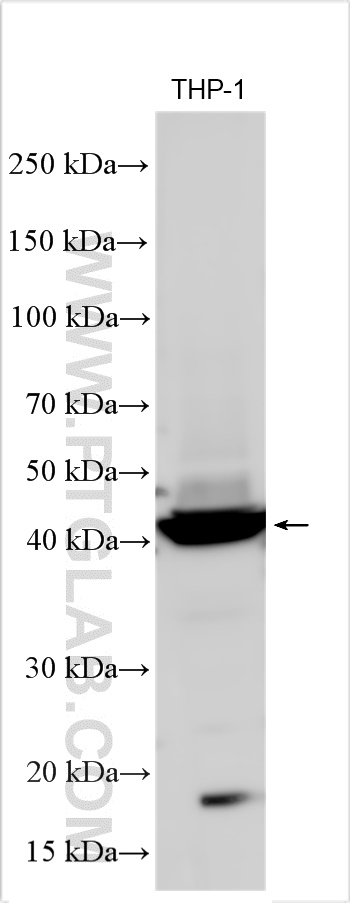验证数据展示
经过测试的应用
| Positive WB detected in | THP-1 cells, mouse testis tissue, rat testis tissue |
推荐稀释比
| 应用 | 推荐稀释比 |
|---|---|
| Western Blot (WB) | WB : 1:500-1:3000 |
| It is recommended that this reagent should be titrated in each testing system to obtain optimal results. | |
| Sample-dependent, Check data in validation data gallery. | |
产品信息
13960-1-AP targets WDFY1 in WB, ELISA applications and shows reactivity with human, mouse, rat samples.
| 经测试应用 | WB, ELISA Application Description |
| 经测试反应性 | human, mouse, rat |
| 免疫原 | WDFY1 fusion protein Ag4877 种属同源性预测 |
| 宿主/亚型 | Rabbit / IgG |
| 抗体类别 | Polyclonal |
| 产品类型 | Antibody |
| 全称 | WD repeat and FYVE domain containing 1 |
| 别名 | WD repeat and FYVE domain-containing protein 1, Phosphoinositide-binding protein 1, KIAA1435, FYVE domain-containing protein localized to endosomes 1, FENS-1 |
| 计算分子量 | 410 aa, 46 kDa |
| 观测分子量 | 43-46 kDa |
| GenBank蛋白编号 | BC040525 |
| 基因名称 | WDFY1 |
| Gene ID (NCBI) | 57590 |
| 偶联类型 | Unconjugated |
| 形式 | Liquid |
| 纯化方式 | Antigen affinity purification |
| UNIPROT ID | Q8IWB7 |
| 储存缓冲液 | PBS with 0.02% sodium azide and 50% glycerol , pH 7.3 |
| 储存条件 | Store at -20°C. Stable for one year after shipment. Aliquoting is unnecessary for -20oC storage. |
背景介绍
WD repeating domain FYVE1 (WDFY1) belongs to the WD40 protein family, which plays key roles in diverse cellular processes, including signal transduction, gene transcription, vesicle fusion, and spermatogenesis(PMID: 32867693; PMID: 10322433). WDFY1 is highly expressed in mouse testis and is dispensable for mouse spermatogenesis and male fertility (PMID: 35121371). The bands of 24 kDa and 19 kDa may be potential isoforms of WDFY1.
实验方案
| Product Specific Protocols | |
|---|---|
| WB protocol for WDFY1 antibody 13960-1-AP | Download protocol |
| Standard Protocols | |
|---|---|
| Click here to view our Standard Protocols |

